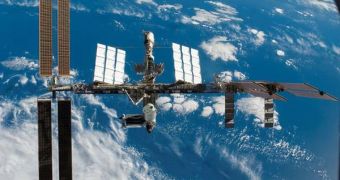On Sunday, the International Space Station was again confronted with the possibility of a violent collision with a piece of space junk, and NASA mission controllers back on Earth asked the crews to reorient the shuttle-space station complex to a modified orbit. This allowed the orbiting lab to significantly increase its distance from the 10-year-old piece of Chinese satellite engine. The move was ordered with today's planned spacewalk in mind, as the 4-inch (10-centimeter) -long piece of junk was to pass uncomfortably close to the astronauts working in the harsh environment of the outer space.
Rather than engaging in delicate maneuvers to pull the two crafts out of harm's way, flight controllers employed a more natural method of altering the station's orbit, and advised the Discovery space shuttle to fire up its thrusters and move in front of the ISS, so that it's belly was straight against the orbital path. The large area of the craft's belly and wings creates a natural drag, which slows down the entire complex by more than one foot per second, which is enough to considerably increase the distance between the ships and the piece of space junk.
Monday's spacewalk is absolutely essential for the ISS, as astronauts Joseph Acaba and Richard Arnold II will exit the ISS again in order to properly deploy the equipment shelves located on the station truss rod. It became stuck on Saturday, during the mission's second spacewalk, and astronauts found it impossible to unstuck it at the time. Now, the pair will try to fully deploy the equipment shelves both at that location and on the other side of the rod as well.
These compartments are vital to the ISS, as they will hold spare parts that are simply too big to be fitted in the station itself. This emergency plan is absolutely necessary, considering that the shuttle fleet will be withdrawn in 2010, and that there will be no other crafts with similar capabilities available until 2015. Until then, the crew aboard the lab will only travel back and forth in Russian Soyuz crafts, and all the traffic to the ISS will be performed with the help of the Russians.

 14 DAY TRIAL //
14 DAY TRIAL //